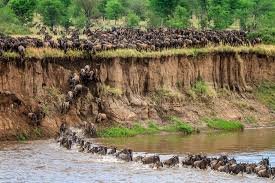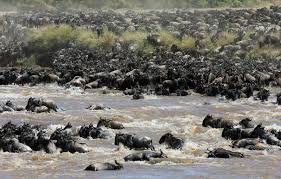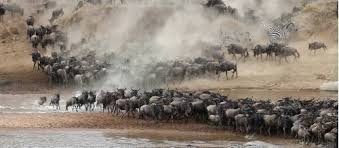My first blog in this community is about what is frankly, a marvel. This annual migration is one of the greatest wildlife spectacles on earth. At the start of the year, the herds are spread along the short grass plains of the southern Serengeti. Here they are grazing and preparing themselves for calving.
February is Peak calving season, with tens of thousands of calves born daily, for a three-week period in what is probably one of the most synchronized birthings of mammals in nature. Predator concentration is also at its peak, with lions, cheetahs, hyenas, and other predators having a free for all during this season of abundance. No wonder the calves are up and running as fast as their mothers within 45 minutes of birth!
In March, as the calves begin to grow, the herds begin to move West and North, in the direction of the western woodlands. In April, the mega-herd wields north, to the central Serengeti. This is the easiest part of the Serengeti to access for visitors and hence, the busiest part of the Serengeti National Park.
In May, they move west again in a series of thundering columns, each containing thousands of animals. Once they start to move, the pace can be rapid, so the best place to see a large swarm of these gnu’s is the central Serengeti.
June is the rut or mating season. By this time, many herds gather in the western corridor, halted briefly by the Grumeti River. Typically, from June Until early July, the animals cross the Grumeti River, where they are met by fearsome crocodiles which have been waiting all year to gorge themselves on this passing buffet.
After the Grumeti, the herds move towards Northern Serengeti, and Kenya’s Maasai Mara. In August, the bulk of the herds continue moving north, into the Maasai Mara. By early September, the herds are grazing on the banks of the Mara river, with their six-month-old calves, eating, resting, and gathering strength.
Crossings of the Mara River are frequent at this time of the year. The herds jostle along the banks of the river, jostling and diving into the deep, crocodile-infested waters. Needless to say, a lot of them are drowned, trampled to death, or eaten by the crocs. Usually, by October, the reduced herds begin the long trek back into Tanzania and the southern Serengeti.
Those still on the Northern side of the Mara River often make dramatic crossings at this time. As the rains start in the plains of the southern Serengeti, progress is usually slow, as most of the females are heavily pregnant.
By December, the herds are in residence again in the southern Serengeti, where the mineral-rich grass north of the Ngorongoro conservation area provides nutrients for calving. And the dance begins again. No wonder it’s called the greatest show on earth, and one of the seven wonders of the modern world!


